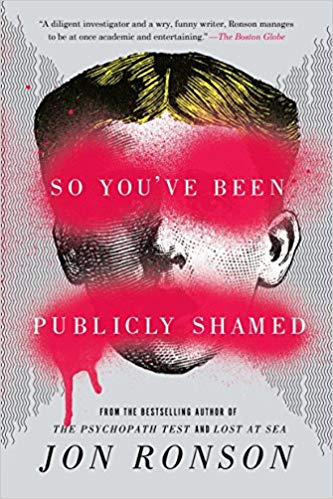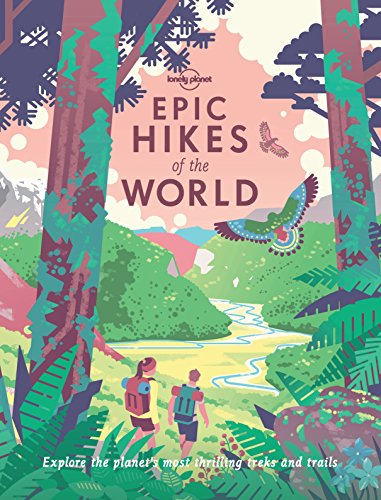Last year around this time, while most of the other outdoor sites were listing off new and fancy gear you could drop a couple of hundreds of dollars on for the holidays, I got a little more inspired by the Icelandic tradition of Jolabokaflod (which translates to “Christmas book flood” because Icelandic is a magical language). The tradition involves giving books to loved ones on Christmas Eve and then spending the night reading – which just sounds lovely, don’t you think?
Related: Best Guidebooks of 2017 and Best Outdoor Books of 2017
No matter what holiday you celebrate – or if you’re just biding time until New Year’s Eve’s champagne parties – here are some of my favorite books I’ve read this year. These have helped me get a better perspective about the Outdoors, the West, or the world of the online outdoors and social media, too.
I’ll also note that now is an excellent time to pick up copies of books by Modern Hiker authors, including:
Day Hiking Los Angeles – Casey Schreiner
Afoot and Afield in San Diego County – Scott Turner
Hiking the Pacific Crest Trail: Southern California – Shawnté Salabert
75 Great Hikes: Seattle – Melissa Ozbek
Death Valley National Park – Jenna Blough
THE CALIFORNIA FIELD ATLAS – OBI KAUFMANN
It is not only water in California that brings life to the forests, but also fire. Fire is the great equalizer that draws the lines, thins the fat, frees the space, opens the seeds, moves the land, and calls the wildflowers.
It’s tough to even know how to write about this book. Kaufmann has been working on it for almost his entire life. It’s a field guide. It’s an art book. It’s philosophy. It doesn’t necessarily have to be read front to back. And it’s a book you’ll want to spend a lot of time digesting in small pieces. Filled with original watercolor maps and beautiful paintings of California’s flora and fauna, this field atlas takes the usual political and transportation maps of California and replaces them with maps of watersheds, biomes, tectonic plates, and habitats. It forces you to rethink the way you look at the state and its landscape, and it’s gorgeous to look at, too.
NATURE POEM – TOMMY PICO
I feel dry as California
where I somehow managed to thrive
in a climate of drought for thousands
of years w/o draining the state, yet
somehow we were primitive?
This book-length poem by Tommy Pico is a really fun, rollicking, and excellent read. Pico identifies as a queer Kumeyaay who grew up outside San Diego but currently lives in Brooklyn, and this poem is a complaint about the cultural expectation placed upon him to write a nature poem that eventually becomes its own kind of nature poem.
The writing here is sarcastic, biting, and beautiful – swinging wildly from impressionistic imagery to Instagram captions to vulgar queer slang and Twitter abbreviations. It may not be for everyone, but I found myself laughing out loud and highlighting tons and tons of striking passages along the way.
THE NATURE PRINCIPLE – RICHARD LOUV
By its broadest interpretation, nature-deficit disorder is an atrophied awareness, a diminished ability to find meaning in the life that surrounds us, whatever form it takes.
If you’ve heard of “Nature Deficit Disorder,” you’ve heard of this book. Louv first wrote about this concept in 2008’s “Last Child in the Woods.” Although the research in this field has advanced a bit since Louv wrote this follow-up in 2012, this book is more about Western civilization’s continuing trend toward technology as the savior of humanity … often at the detriment of the importance of spending time in nature.
The first part of this book focuses on research and data that show time spent in nature or being near nature can boost mental and creative health along with physical health, and that taken on a broader society-level scale, those some things can promote smarter, stronger, more equitable businesses and economies. The book ends with a vision of a more ecologically balanced world that — while looks a little less possible in 2018 — still inspires in the face of bad news.
SO YOU’VE BEEN PUBLICLY SHAMED – RON JOHNSON
“Social media shamings are worse than your shamings,” I suddenly said to Ted Poe. He looked taken aback. “They are worse,” he replied. “They’re anonymous.” “Or even if they’re not anonymous, it’s such a pile-on they may as well be,” I said. “They’re brutal,” he said. I suddenly became aware that throughout our conversation I’d been using the word they. And each time I did, it felt like I was being spineless. The fact was, they weren’t brutal. We were brutal.
Modern Hiker was there at the beginning of the outdoor world’s emergence onto social media … and we were also there for its first big public shaming when we broke the story of Casey Nocket’s vandalism spree. Unfortunately, more followed — from well-known graffiti artist Mr. André vandalizing Joshua Tree National Park (and then trying to sue me for catching him), to the wider general social media masses using public spaces as backdrops for illegal activities to get more likes. Now the phrase “loved to death” is almost a cliché when talking about the outdoors, but public agencies and the public are both getting better about using social media to fight back.
There are lots of people doing this in a thoughtful, measured manner — but where should a line be drawn? When does shaming of an act become worse than the act itself?
In Johnson’s book, he looks at the history of shame being used as a punishment and details some high-profile early examples of internet shaming to show just how quickly the internet mob can go from justice-minded to bloodthirsty — and what effect that has on the people who find themselves at the receiving end of these Instagram vigilantes. It’s definitely given me pause when deciding whether or not to share some of the images I still get sent — and has helped me try to figure out when it’s appropriate to go public with outdoor vandalism and when it’s best to just leave it to the authorities (spoiler: it’s almost ALWAYS better to just forward to law enforcement).
A SAND COUNTY ALMANAC – ALDO LEOPOLD
There is value in any experience that reminds us of our dependency on the soil-plant-animal-man food chain, and of the fundamental organization of the biota. Civilization has so cluttered this elemental man-earth relation with gadgets and middlemen that awareness of it is growing dim.
Aldo Leopold is a leading figure for wildlife conservation and public land management, and “A Sand County Almanac” is a beautiful book that serves as a spiritual connection between “Walden,” “Desert Solitaire,” and “Silent Spring.” The first section of this book is an incredibly detailed journal of his time spent on a small farm in Wisconsin. Through the seasons, he notes individual species of plants that have come and gone with the tides of settlers, describes chopping down a tree and sitting in a canoe on a calm lake. The second section takes him on travels throughout Western North America as he develops his concept of land ethics and the soil-plant-land-animal-man chain. And he finishes up with a philosophical section where he attempts to synthesize all of his life experiences into a way of thinking that would encourage people to more strongly value their connection with land and place.
Leopold also has a LOT to say about outdoor recreation, too. Consider these quotes:
To him who seeks in the woods and mountains only those things obtainable from travel or golf, the present situation is tolerable. But to him who seeks something more, recreation has become a self-destructive process of seeking but never quite finding, a major frustration of mechanized society … At some near-by resort is still another nature-lover—the kind who writes bad verse on birchbark. Everywhere is the unspecialized motorist whose recreation is mileage, who has run the gamut of the National Parks in one summer, and now is headed for Mexico City and points south.”
This book was written in 1949. Leopold is definitely a mild-mannered midwesterner, but you can clearly see his prickly wit in here. You wonder if he’d be a little more foul-mouthed like Ed Abbey if he lived to see the Instagram age.
TEN ARGUMENTS FOR DELETING YOUR SOCIAL MEDIA ACCOUNTS RIGHT NOW – JARON LANIER
How can you remain autonomous in a world where you are under constant surveillance and are constantly prodded by algorithms run by some of the richest corporations in history, which have no way of making money except by being paid to manipulate your behavior?
I mean, just look at that title, right?
The truth is, the book is not as bombastic as the title would lead you to believe (gotta fight those algorithms, ya know), and Lanier is even OK with you not deleting any of your social media accounts — as long as you take the time to think about how your post is affecting your behavior and your followers and who it’s benefiting in the long run.
In case you can’t tell, I’ve been doing a lot of thinking about social media this year, and I really do think this quick book is a must-read for anyone who wishes social media companies and platforms were better than they are — which, really, isn’t asking a whole lot when you think about it. This book does get a little jargon-y at times, but the message is always loud and clear, even if it’s not always easy to listen to.
CALIFORNIA PLANTS: A GUIDE TO OUR ICONIC FLORA – MATT RITTER
Every plant tells a story about a place, the workings of nature, and California’s history.
I’ve found that many hikers also have a hiking-adjacent interest that, when sparked, will tremendously increase their enjoyment and appreciation of their time spent on the trails. For me, it was history first, followed later by the desire to know more about all these plants I kept seeing on my hikes. I took some classes at the Theodore Payne Foundation and started planting my own miniature native garden, but when I’m outside my local chaparral and coastal sage scrub I often once again find myself saying, “what is THAT plant?”
Matt Ritter’s exhaustive field guide documents more than 500 species of native California plants with over 1000 beautiful full-color photographs. The plants are organized into broad terrain-types and each entry also features a general range map, making it easy even for novices to figure out what plant caught their eye on the trail … and Ritter also has a section of common non-native plants, too. In the back of the book, there’s a flowchart to help you figure out what kind of California tree you’re looking at and a color index of California wildflowers, too. This is an exceptionally useful AND easy to use guide that’s great for beginners and intermediate native plant-spotters alike.
LONELY PLANET EPIC HIKES OF THE WORLD – VARIOUS AUTHORS
Now I have my issues with hiking lists, but coffee table books like this are a great way to daydream about exploring places you may not have ever considered. This particular book also has the distinction of having beautiful photography and artwork and the fantastic storytelling you’d expect from a Lonely Planet guide. The book is organized by continent and includes a range of experiences — so it treats Boston’s Freedom Trail with the same detail and reverence as New Zealand’s Routeburn Track.
Another nice touch is that every featured hike ends with a “More Like This” section that shows off similar experiences all over the world … so maybe you won’t be able to hike the coast-to-coast route along Hadrian’s Wall in Great Britain but the Transcontinental Rainforest Trek in Costa Rica is more your speed.








